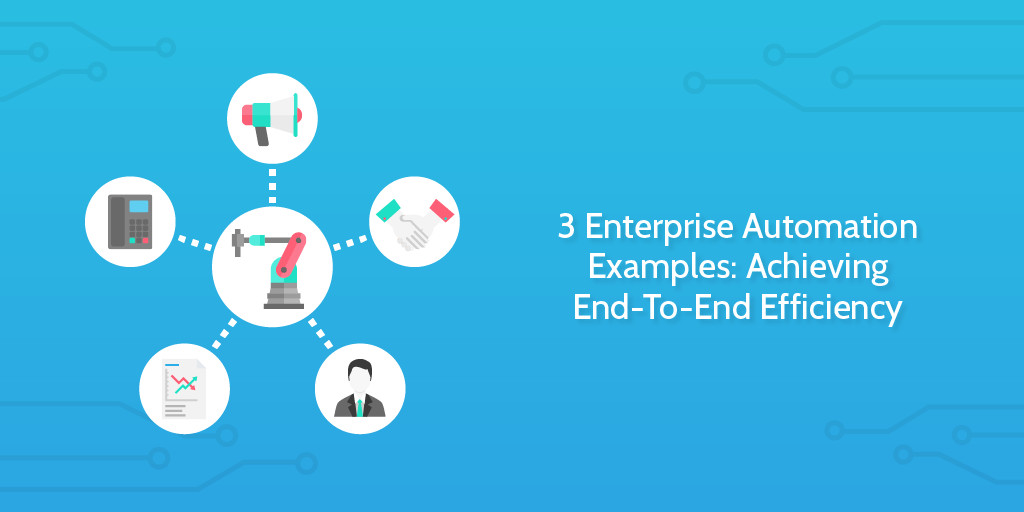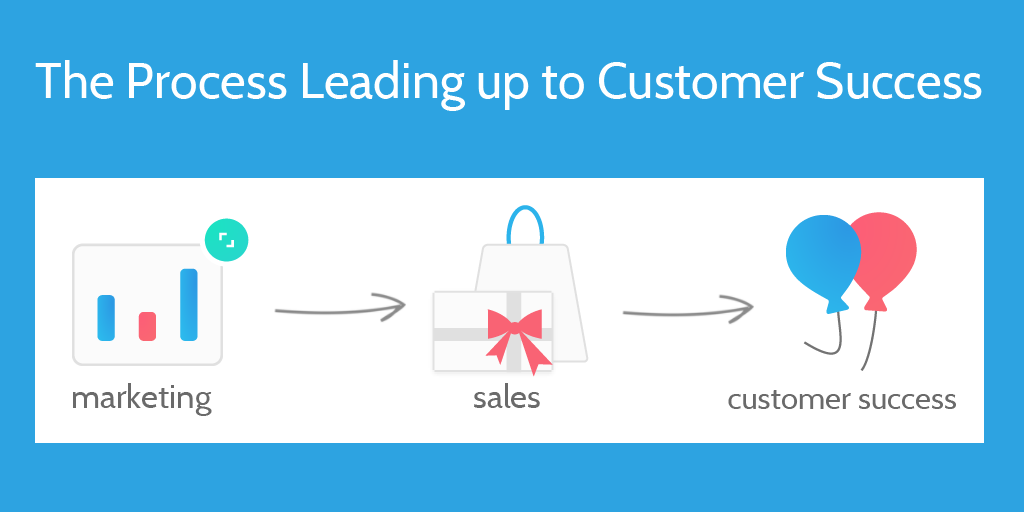
Research indicates that inefficient workflows can cost up to 30% of your total revenue every year. That’s a third of your enterprise’s earning being wasted on everything from a single missed email to a stock of excess inventory.
Imagine what you could do with that money. You could hire new employees to scale your business even further. Department budgets could be expanded to allow better equipment to be used.
All of this and more can be achieved with business process automation.
To demonstrate, let’s go over three core automation examples for processes which often include many of those typical inefficiencies, such as:
- Customer success (client onboarding process)
- HR (recruitment process)
- Support (customer support process)
All of these processes will be given in full, and by the end of this post you’ll know how to eliminate inefficiency by using basic, process, integration, and robotic automation.
It’s time to take back that 30% of your revenue.
Customer success automation example
Customer success is difficult at the best of times, but is nonetheless vital to any successful enterprise. You’ve spent the time and money on marketing and sales to get your customers, but to make sure that they stick around you need to have a strong client onboarding process.

Having said that, the amount of time and effort you can waste during onboarding is massive, especially considering the number of programs and various employees you’ll need to use in the process. Not to mention that any mistakes can sour the relationship you have with the client, potentially causing them to churn or even spread the word that your services are sub-par and putting others off.
In other words, it’s a perfect automation example to show the kind of tasks you can streamline and get rid of altogether by using the different kinds of enterprise automation.
A quick note before we dive in though; these processes will obviously differ slightly, and all will contain some degree of automation. This will usually come in the form of basic automation (such as using a CRM to manage your customer data), but for the most part the truly powerful techniques will be left out to show the comparison.
Traditional client onboarding
A traditional enterprise client onboarding process might look like this:
- Lead converts into a client
- CRM entry is updated (/created) to log the new customer
- Client value assessed and employee chosen with proportional experience for client onboarding
- Employee is tagged in the client’s CRM entry to make them easy to find
- Client onboarding is performed
While this fulfills the basic requirements of client onboarding, it leaves far too much open to error and inefficiency.

For example, the Project Management Institute has indicated that 56% of all funding considered “at risk” in company projects ($75 million for every $1 billion) is due to ineffective communication. Information is lost, forgotten, or confused, and there is nothing in this traditional process to solve that.
Even if the responsible employee starts the client onboarding process as quickly as possible, the process itself is entirely down to the employee in question. This means that the success of the entire operation is left down to a single person’s memory and the chance of human error.
While this might be okay for smaller organizations where managers have the time to keep track of every employee and their processes, in an enterprise dealing with hundreds or thousands of clients per team it simply isn’t reliable.
Automated client onboarding
In contrast, an optimized and automated client onboarding process would look something like this:
- Lead converts into a client
- Lead status updated in CRM (Salesforce)
- Client onboarding checklist automatically triggered to run in Process Street
- Client information automatically pushed into the new checklist
- Basic onboarding material automatically sent to client in an email
- Employee checks their Process Street inbox to see what they need to do
- Employee performs the client onboarding process using the instructions provided in the checklist
Immediately, it’s obvious that much less of this process relies on inefficient communication and limits the risk of human error.
Communication isn’t an issue because all of the steps that would require it (e.g. telling the employee to perform client onboarding) are now automatically taken care of as soon as the client status is updated. No information is lost during these steps either, as the onboarding checklist is automatically populated with all of the relevant information.
Not to mention that this makes client onboarding easier to track and review as a manager, as all you have to do is use the template overview tab in Process Street to get a summary of every checklist run.
Human error is also less of a problem, as the employee is no longer relying on their memory in order to carry out the client onboarding process. Process Street checklists are made up of tasks which can be as detailed as needed, including direct instructions, supporting materials, and much more.
None of this is difficult to set up either. To automatically run a checklist and populate it with information, you can:
- Create a custom button inside Salesforce using checklist run links and variables (click here for instructions)
- Integrate Salesforce and Process Street using third-party software (such as Zapier)
As for setting up your checklist in Process Street, try importing our pre-made client onboarding process. It’s ready to use as it is and completely free to import. Plus, if it’s not suitable for your needs (e.g. you’re not a marketing agency) then it still serves as a solid base which you can edit to your heart’s content.
HR automation example
The US Department of Labor estimates the cost of a bad hire to be 30% of the employee’s first year of wages. Add to that the estimated cost of employee onboarding (according to leading recruiters) being $240,000, and that a heck of a lot of money to waste on bad hires or ineffective onboarding.
Beyond that, bad recruitment practices (and therefore bad hires) disrupt your existing team and make them less efficient, doubling up the overall cost in terms of productivity.
That’s why the hiring process is the next of our automation examples.
Traditional hiring process
A traditional hiring process might look like this:
- Current team needs to expand, or a new role is required
- The decision is made to hire a new employee
- One employee is assigned to write a job description
- The job description is posted in all relevant areas (websites, newspapers, etc.)
- Job applications are collected
- Initial checks are performed to eliminate unsuitable candidates
- Thorough checks are performed to assess the most suitable candidates
- Interviews are conducted
- The best hire is chosen (usually via manager decision)
- Employee onboarding is performed
Again, this recruitment process will certainly fulfill the basic hiring needs, but the vulnerabilities and inefficiencies in this process make it almost unsustainable at an enterprise level.
To name but a few problems:
- There’s no way to standardize/easily monitor the job description
- There’s no guarantee the job will be posted in every relevant area
- Job applications have no central location stored, and can therefore be lost
- The entire screening and interview process relies entirely on employee accountability (which is not enforced)
- The steps in employee onboarding are vague and inconsistent between employees
Automated hiring process
An automated hiring process would look more like the following:
- The decision is made to hire a new employee
- A hiring process checklist is run in Process Street
- An employee selects the department and position being hired for using a drop-down menu in the checklist
- The checklist updates to reflect the required tasks to effectively recruit and onboard this type of employee
- Pre-written job descriptions are provided, letting an employee copy it directly into all relevant locations (which are also documented)
- Applications are stored in a central location, such as a set Google Drive folder
- Checks are performed as normal, but each round of checks is automatically assigned to specific employees in Process Street
- The interview task contains a link which is clicked to run fresh interview checklist for every candidate
- Interview responses are recorded in the checklist to centralize all information
- The employee onboarding process is automatically run when the hiring process is completed
- All relevant information is pushed through from the hiring process to let onboarding begin immediately
As with the client onboarding process, this automated process relies much less on memory, is more consistent in execution, and largely eliminates human error. By doing this you can ensure both that’s you are hiring the right employees and that employee onboarding will be as successful as possible.
Here at Process Street, we have both a recruitment process and an employee onboarding checklist ready to use for free. They’re ready to use as they are, but can also be edited to suit your specific needs. Check them out below.
As for how to set up a checklist which adapts to suit the information you enter (e.g., customizing the hiring process based on the required employee), conditional logic allows you to set rules for your checklist to follow. For example, you could hide most of your tasks by default, then show sections related to various options in an initial dropdown form field.
The following also contribute to making the automated hiring process much more reliable in an enterprise setting:
- The checklist automatically assigns employees to their relevant tasks to enforce accountability
- Due dates are automatically set to let employees know when they need to work on each task
- The process itself can adapt based on the department and position being advertised to encourage more suitable applicants
- Any actions and current progress can be checked at a glance by the team manager to ensure transparency in the process.
Support automation example
Bad customer support costs businesses more than $62 billion every year.
Whether it’s through inefficiency, slow responses, or unsatisfied customers, this is a problem affecting hundreds of thousands of traditional businesses and enterprises. The top causes of this include a lack of proper training and customer receiving incorrect responses to their support queries.

So, let’s solve those issues, shall we?
Traditional customer support
The traditional customer support process is as follows:
- A customer reaches out to your support channel with their issue
- The employee at hand receives their message (through phone, email, in-app messaging, etc)
- They attempt to solve the problem to the best of their ability
- If unable to do so, the customer is passed onto a more experienced team member
- The customer repeats their issue to the new technician
- The technician attempts to solve the issue with their more specialized knowledge
This process repeats until a solution is found, the customer stops responding (or hangs up), or an explanation is found and the customer notified that the issue will be worked on (e.g., a new bug is discovered in your software).
As with our previous examples, the problems with this process are immediately obvious:
- The customer has to repeat their issue to every employee
- Response time is variable and entirely dependent on the support technicians available
- Individual support cases are not tracked, making it next to impossible to see where problems are occurring
- Hand-off between technicians is unpredictable, causing further delays
- Solutions are entirely dependent on the knowledge, experience, and understanding of the support technician
Automated customer support
To solve these issues, the customer support process must be standardized and monitored, while giving technicians access to all of the information they might require.
Thus an automated customer support process consists of the following:
- A customer contacts your support team with an issue
- Your customer support checklist is automatically run in Process Street
- Customer information and their message are automatically pushed into the checklist
- The support request is prioritized based on the value of the customer
- The checklist is automatically assigned to a low-level support employee
- The employee opens the checklist and categorizes the type of issue (technical, payment, feature request, etc)
- The checklist automatically updates to show instructions for dealing with that type of issue
- The employee replies immediately with either a solution or to let the customer know that they’re looking into it
- If the employee cannot solve the issue it is escalated to a senior support technician and the customer is notified
- The senior technician is assigned to the checklist and can immediately see all relevant information to solve the issue
By doing this, customers only have to state the issue they are having once, which creates a much better support experience. Not only that, but without having to chase down relevant information or instructions for dealing with specific issues, low-level support employees are able to give much quicker responses and are able to solve more issues.
Research indicates that employees spend 20%-40% of their time manually searching for documents. So, by having all of your instructions, solutions, and relevant information in a single location, you’re effectively letting your employees spend 1.25x as much time actually solving customer support issues.
Low-level technicians being able to handle and solve more support issues also allows your higher-level technicians to focus on the cases where they are actually needed. This, in turn, provides a much more successful and pleasant support experience to your audience, helping to cement people as return customers.
Stop wasting time and start automating your enterprise
Automation doesn’t have to be intimidating, because there’s no downside to deploying it in your organization. It won’t replace your team members, but instead make them more effective at their jobs be removing menial, repetitive tasks and streamlining their processes.
Research also indicates that 81% of UK companies will need greater automation by 2020 in order to cope with their increased workloads. This means that, for many, automation isn’t just a way of saving huge amounts of time and money – it’s essential to staying competitive and running a profitable business.
Not sure where to start? Don’t worry. Process Street has a huge number of tutorials on our help site, and by signing up for a free account today you’ll be able to access our premade process templates and get a head start on documenting on optimizing your own practices.
See you on the inside!
Have any questions? I’d love to chat in the comments below.







 Workflows
Workflows Projects
Projects Data Sets
Data Sets Forms
Forms Pages
Pages Automations
Automations Analytics
Analytics Apps
Apps Integrations
Integrations
 Property management
Property management
 Human resources
Human resources
 Customer management
Customer management
 Information technology
Information technology



Ben Mulholland
Ben Mulholland is an Editor at Process Street, and winds down with a casual article or two on Mulholland Writing. Find him on Twitter here.